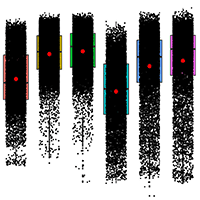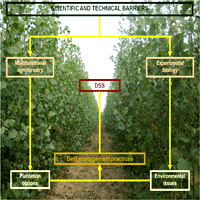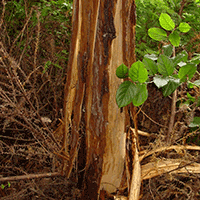
Rewilding beech-dominated temperate forest ecosystems: effects on carbon stocks and biodiversity indicators
Katarína Markuljaková (1) , Martin Mikoláš (1), Marek Svitok (1-2-3), Garrett W Meigs (4-5), William S Keeton (6), Daniel Kozák (1), Jakob Pavlin (1), Rhiannon Gloor (1), Michal Kalaš (7-8), Matej Ferenčík (1), Dheeraj Ralhan (1), Michal Frankovič (1), Jenýk Hofmeister (1), Daniela Dúhová (1), Marek Mejstrík (1), Martin Dušátko (1), Antonín Veber (1), Tomáš Knír (1), Miroslav Svoboda (1)
iForest - Biogeosciences and Forestry, Volume 18, Issue 1, Pages 1-9 (2025)
doi: https://doi.org/10.3832/ifor4600-017
Published: Feb 02, 2025 - Copyright © 2025 SISEF
Research Articles
Abstract
Maximising carbon stock and habitat availability is a critical objective of contemporary forest management, with primary forests serving a crucial function due to their substantial carbon storage potential and biodiversity values. Given the limited extent and fragmentation of primary (mature and old-growth with minimal prior management) forests in Europe, there is a growing interest in understanding how rewilding (long-term management cessation) affects carbon stock and habitat provisioning. Further, little is known about the conditions required for secondary old-growth forests to achieve the carbon volumes and late-successional habitat features associated with primary forests if designated as rewilding areas. Rewilding of forest ecosystems in Europe is still a widely debated strategy, highlighting the importance of evidence-based examples. We compared some of the best-preserved primary old-growth forests with adjacent secondary old-growth forests which have been allowed to undergo self-development for an extended period of seven decades in the ecologically and socially important beech-dominated forests of the Carpathian Mountains. Statistical analysis showed no significant differences in carbon stock and structural biodiversity indicators between the two forest categories. Mean aboveground carbon stock was 207 Mg ha-1 in primary and 213 Mg ha-1 in secondary old-growth plots, which contrasts with values of 107 Mg ha-1 found in managed beech forest stands from the same region. The aboveground biomass carbon increment was 4.3 Mg ha-1 year-1 in primary and 4.5 Mg ha-1 year-1 in secondary plots, respectively. Notably, deadwood volume exhibited the most substantial variation among forest types along with tree microhabitat diversity. Our findings underscore the vital role of protecting and restoring old-growth forest ecosystems for effective carbon stock and biodiversity conservation. We emphasise that forest heterogeneity, encompassing factors such as tree age and diameter, canopy layer, species composition, and growth patterns, are important for enabling managed forests to reach peak carbon storage capacity. Although 70 years is insufficient for secondary old-growth forests to fully recover primary forest characteristics, our study demonstrates that similar structures and functions can develop within less than a century of protection in productive temperate regions of Europe. This study supports rewilding as an effective conservation strategy and Natural Climate Solution.
Keywords
Carbon Stock, Tree Ring Increment, Carpathian Mountains, Secondary Old-growth Forests, Deadwood, Tree Microhabitats, Restoration, Large Trees
Authors’ Info
Authors’ address
Martin Mikoláš 0000-0002-3637-3074
Marek Svitok 0000-0003-2710-8102
Daniel Kozák 0000-0002-2622-370X
Jakob Pavlin 0000-0001-8514-3446
Rhiannon Gloor
Matej Ferenčík 0009-0002-6235-6873
Dheeraj Ralhan 0000-0003-2813-7685
Michal Frankovič 0000-0003-2772-3738
Jenýk Hofmeister 0000-0002-3915-5056
Daniela Dúhová 0009-0004-2275-1304
Marek Mejstrík
Martin Dušátko 0000-0002-3463-607X
Antonín Veber 0009-0001-4937-7779
Tomáš Knír
Miroslav Svoboda 0000-0003-4050-3422
Department of Forest Ecology, Faculty of Forestry and Wood Sciences, Czech University of Life Sciences Prague, Kamýcká 129, 165 21 Praha 6 - Suchdol (Czech Republic)
Department of Biology and General Ecology, Faculty of Ecology and Environmental Sciences, Technical University in Zvolen, Masaryka 24, 960 01 Zvolen (Slovakia)
Plant Science and Biodiversity Center, Slovak Academy of Sciences, Dúbravská cesta 9, 845 23 Bratislava (Slovakia)
Washington State Department of Natural Resources, 1111 Washington Street SE, Olympia, WA 98504 (USA)
College of Forestry, Oregon State University, 3100 SW Jefferson Way, Corvallis, OR 97331 (USA)
Rubenstein School of Environment and Natural Resources, University of Vermont, 81 Carrigan Drive, Burlington, VT, 05405 (USA)
Department of Biology, Ecology and Environment, Faculty of Natural Sciences of Matej Bel University in Banská Bystrica, Tajovského 40, 974 01, Banská Bystrica (Slovakia)
Administration of the Malá Fatra National Park, Hrnčiarska 197, 013 03 Varín (Slovakia)
Corresponding author
Paper Info
Citation
Markuljaková K, Mikoláš M, Svitok M, Meigs GW, Keeton WS, Kozák D, Pavlin J, Gloor R, Kalaš M, Ferenčík M, Ralhan D, Frankovič M, Hofmeister J, Dúhová D, Mejstrík M, Dušátko M, Veber A, Knír T, Svoboda M (2025). Rewilding beech-dominated temperate forest ecosystems: effects on carbon stocks and biodiversity indicators. iForest 18: 1-9. - doi: 10.3832/ifor4600-017
Academic Editor
Gianluca Piovesan
Paper history
Received: Mar 10, 2024
Accepted: Nov 05, 2024
First online: Feb 02, 2025
Publication Date: Feb 28, 2025
Publication Time: 2.97 months
Copyright Information
© SISEF - The Italian Society of Silviculture and Forest Ecology 2025
Open Access
This article is distributed under the terms of the Creative Commons Attribution-Non Commercial 4.0 International (https://creativecommons.org/licenses/by-nc/4.0/), which permits unrestricted use, distribution, and reproduction in any medium, provided you give appropriate credit to the original author(s) and the source, provide a link to the Creative Commons license, and indicate if changes were made.
Web Metrics
Breakdown by View Type
Article Usage
Total Article Views: 8715
(from publication date up to now)
Breakdown by View Type
HTML Page Views: 3569
Abstract Page Views: 2292
PDF Downloads: 2639
Citation/Reference Downloads: 5
XML Downloads: 210
Web Metrics
Days since publication: 313
Overall contacts: 8715
Avg. contacts per week: 194.90
Citation Metrics
Article Citations
Article citations are based on data periodically collected from the Clarivate Web of Science web site
(last update: Mar 2025)
(No citations were found up to date. Please come back later)
Publication Metrics
by Dimensions ©
Articles citing this article
List of the papers citing this article based on CrossRef Cited-by.
References
Close-to-nature forest management in Europe: does it support complexity and adaptability of forest ecosystems? In: “Managing Forests as Complex Adaptive Systems: Building Resilience to the Challenge of Global Change” (Messier C, Puettmann KJ and Coates KD eds). Routledge, London, UK, pp. 187-213.
CrossRef | Gscholar
Guiding principles for rewilding. Conservation Biology 35: 1882-1893.
CrossRef | Gscholar
Generalized biomass and leaf area allometric equations for European tree species incorporating stand structure, tree age and climate. Forest Ecology and Management 396: 160-175.
CrossRef | Gscholar
Natural dynamics of temperate mountain beech-dominated primary forests in Central Europe. Forest Ecology and Management 479 (9): 118522.
CrossRef | Gscholar
Carbon-carrying capacity in primary forests shows potential for mitigation, achieving the European Green Deal 2030 target. Communications Earth and Environment 5: 256.
CrossRef | Gscholar
Profile of tree-related microhabitats in European primary beech-dominated forests. Forest Ecology and Management 429: 363-374.
CrossRef | Gscholar
Importance of conserving large and old trees to continuity of tree-related microhabitats. Conservation Biology 37 (3): e14066.
CrossRef | Gscholar
Patterns of forest dynamics in a secondary old-growth beech-dominated forest in the Jizera Mountains Beech Forest Reserve, Czech Republic. iForest 12 (1): 17-26.
CrossRef | Gscholar
Global importance of large-diameter trees. Global Ecology and Biogeography 27 (7): 849-864.
CrossRef | Gscholar
Generalized linear models (2nd edn). Chapman and Hall, London, UK, pp. 526.
Gscholar
Primary forest distribution and representation in a Central European landscape: results of a large-scale field-based census. Forest Ecology and Management 449: 117466.
CrossRef | Gscholar
Natural disturbance impacts on trade-offs and co-benefits of forest biodiversity and carbon. Proceedings of the Royal Society B: Biological Sciences 288: 20211631.
CrossRef | Gscholar
Temperate primary forest biomass accumulates over centuries-long time frames. Ecosystems 26 (8): 1685-1702.
CrossRef | Gscholar
Where are Europe’s last primary forests? Diversity Distribution 24 (10): 1426-1439.
CrossRef | Gscholar
The legacy of disturbance on individual tree and stand-level aboveground biomass accumulation and stocks in primary mountain Picea abies forests. Forest Ecology and Management 373: 108-115.
CrossRef | Gscholar
The line intersect method in forest fuel sampling. Forest Science 14 (1): 20-26.
Gscholar

















